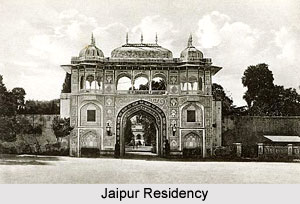The Rajputana Agency is a former political unit of the British Empire in India, which supervised and administered a collection of princely states of India that are located in the modern day Rajasthan, northwestern India. The Agency was managed by a Resident of British India, also known as political agent, of the Governor General of the British, who was headquartered in Mount Abu in the Aravalli Mountain Ranges. The Rajputana Agency of the erstwhile British India was spread over a total area of 330,330 sq km and comprised of 18 princely states and 2 chiefships or estates.
The British Government of India sub-divided the Rajputana Agency into 9 distinct groups of states, which consisted of 3 residencies and 6 agencies. These included the following:
Mewar Residency
The Mewar Residency was headquartered at Udaipur and managed and administered the princely state of Mewar, also known as Udaipur.
Western Rajputana States Agency
This agency under the Rajputana Agency administered and governed the Indian princely states of Banswara, Partabgarh and the princely state of Dungarpur. The Western Rajputana States Agency was included in the Mewar Residency but was later separated in the year 1906.
Jaipur Residency
 The Jaipur Residency administered the estate of Lawa and the princely state of Jaipur and Kishangarh. It was headquartered at Jaipur.
The Jaipur Residency administered the estate of Lawa and the princely state of Jaipur and Kishangarh. It was headquartered at Jaipur.
Western Rajputana States Residency
The Western Rajputana States Residency managed the states of Sirohi, Jaisalmer and Jodhpur and had its headquarters at Jodhpur.
Eastern Rajputana States Agency
This agency under the administration of the Rajputana Agency managed the princely state of Bharatpur, Karauli State and Dholpur State and was headquartered at Bharatpur.
Kotah Jhalawar Agency
The Kotah Jhalawar Agency was also a division of the Rajputana Agency under the former British Indian Government. It administered the princely state of Jhalawar and Kotah State.
Haraoti Tonk Agency
This agency had its headquarters at Deoli and supervisied and goverened the administration of the state of Bundi, the princely state of Tonk and the estate of Shahpura.
The other agencies included in this subdivision where, Alwar Agency (headquartered at Alwar), Tarangagadh Agency (headquartered at Taranga) and Bikaner Agency (headquartered at Bikaner). All the princely states in the Rajputana Agency were ruled by Hindu Rajput rulers, except the princely state of Bharatpur and Dholpur that were ruled by Jat rulers and the princely state of Tonk which was administered by Muslim rulers. Ajmer Merwara, which was a small province under the British, was later included in the geographical border of the Rajputana Agency, but was under direct rule British administration. According to the 1901 Census of India, the total population of the region was 9,723,301 and even though the Rajputs reigned over most of the states, still they consisted of a minority of the total population.
Other significant tribes and castes of the Rajputana Agency were the Brahmins, the Bhats and the Jains. The Brahmins were considered as the highest ranking caste and were rather influential. The Bhats acted as the custodians of secular tradition and the Jains were primarily merchants. Other prominent groups were the Gurjars, the Jats, the Meo, the Meenas and the Bhils.
Development of Rajputana Agency
During the rule of the British Empire in India, agriculture was the primary occupation for the majority of the populace. Several agricultural products were exported like cotton, wool, opium, salt and grains. The main imports were hardware, sugar and piece goods. The region under the Rajputana Agency was not much developed in industrial production. The major products that were manufactured included woolen goods and cotton, ivory carving, metal-work and handicrafts.
Rajputana railway, which traversed through out the Agency, was developed from the Malwa branch in the south and deviated to Agra and Delhi in the north. Later the railway system was developed in other parts of the region as well.






































